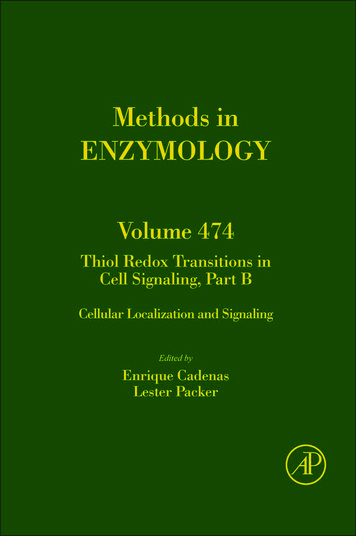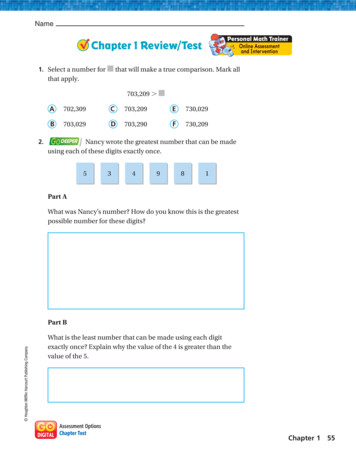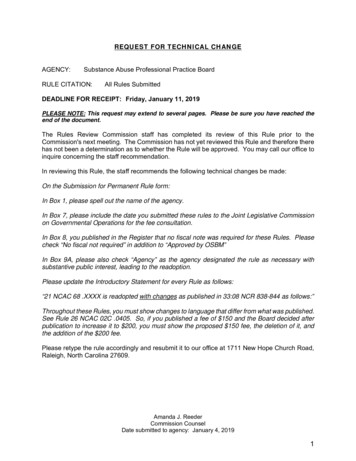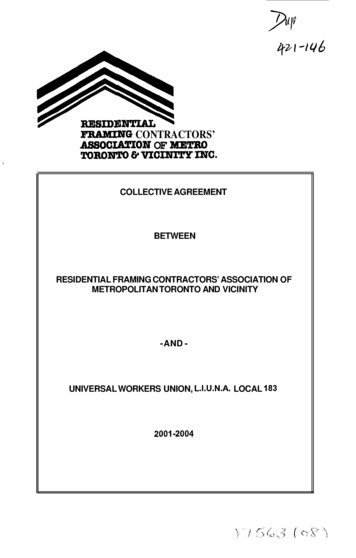
Transcription
VOLUME FOUR HUNDRED AND SEVENT Y-FOURMETHODSINENZYMOLOGYThiol Redox Transitions inCell Signaling, Part BCellular Localization and Signaling
METHODS IN ENZYMOLOGYEditors-in-ChiefJOHN N. ABELSON AND MELVIN I. SIMONDivision of BiologyCalifornia Institute of TechnologyPasadena, California, USAFounding EditorsSIDNEY P. COLOWICK AND NATHAN O. KAPLAN
VOLUME FOUR HUNDRED AND SEVENT Y-FOURMETHODSINENZYMOLOGYThiol Redox Transitions inCell Signaling, Part BCellular Localization and SignalingEDITED BYENRIQUE CADENAS AND LESTER PACKERDepartment of Pharmacology & Pharmaceutical SciencesSchool of PharmacyUniversity of Southern CaliforniaLos Angeles, CA, USAAMSTERDAM BOSTON HEIDELBERG LONDONNEW YORK OXFORD PARIS SAN DIEGOSAN FRANCISCO SINGAPORE SYDNEY TOKYOAcademic Press is an imprint of Elsevier
Academic Press is an imprint of Elsevier525 B Street, Suite 1900, San Diego, CA 92101-4495, USA30 Corporate Drive, Suite 400, Burlington, MA 01803, USA32 Jamestown Road, London NW1 7BY, UKFirst edition 2010Copyright # 2010, Elsevier Inc. All Rights Reserved.No part of this publication may be reproduced, stored in a retrieval system or transmitted in anyform or by any means electronic, mechanical, photocopying, recording or otherwise without theprior written permission of the publisherPermissions may be sought directly from Elsevier’s Science & Technology Rights Departmentin Oxford, UK: phone ( 44) (0) 1865 843830; fax ( 44) (0) 1865 853333; email: permissions@elsevier.com. Alternatively you can submit your request online by visiting the Elsevier web site athttp://elsevier.com/locate/permissions, and selecting Obtaining permission to use Elsevier materialNoticeNo responsibility is assumed by the publisher for any injury and/or damage to persons orproperty as a matter of products liability, negligence or otherwise, or from any use or operationof any methods, products, instructions or ideas contained in the material herein. Because of rapidadvances in the medical sciences, in particular, independent verification of diagnoses and drugdosages should be madeFor information on all Academic Press publicationsvisit our website at elsevierdirect.comISBN: 978-0-12-381003-8ISSN: 0076-6879Printed and bound in United States of America10 11 1210 9 8 7 6 5 4 3 2 1
CONTENTSContributorsPrefaceVolumes in Series1. Engineering of Fluorescent Reporters into Redox Domainsto Monitor Electron Transfersxiiixixxxi1Derek Parsonage, Stacy A. Reeves, P. Andrew Karplus, and Leslie B. Poole1. Introduction2. The Problem: Low Sensitivity and Improperly Rate-LimitedAssays for Redox Functions of Bacterial Peroxiredoxin Systems3. The Solution: Engineering of Fluorescent Redox Reportersinto the N-Terminal Domain of AhpF and E. coli Grx14. Engineering of Disulfide-Containing Electron Acceptor Domainsto Detect Electron Transfers via Fluorescence Changes; Linkageof Fluorescein to Bacterial AhpC via a Reducible Disulfide Bond5. Materials6. Methods7. SummaryReferences2. Blot-Based Detection of Dehydroalanine-Containing GlutathionePeroxidase with the Use of Biotin-Conjugated Cysteamine2347810191923Sue Goo Rhee and Chun-Seok Cho1. Introduction2. Oxidative Inactivation of Glutathione Peroxidase and theConversion of Its Active Site Sec to DHA3. Preparation of Biotin-Conjugated Cysteamine4. Blot-Based Detection of DHA–GPx1 in RBCs5. Effects of Oxidative Stress on the Formation of DHA–GPx1in RBCs6. Concluding RemarksAcknowledgmentReferences2425272829303232v
viContents3. Analysis of the Redox Regulation of Protein TyrosinePhosphatase Superfamily Members Utilizing aCysteinyl-Labeling Assay35Benoit Boivin and Nicholas K. Tonks1. Introduction2. Active-Site Structure, Catalysis, and Oxidation3. Detection Methods4. General Principle of the Assay5. Solutions6. Preparation of the Lysis Buffer7. Preparation of the Hypoxic Glove Box8. Preparation of Cell Lysates9. Cysteinyl-Labeling Assay10. Acute Stimulus-Induced Reversible Oxidation of PTPs11. Perspectives12. ConclusionReferences363739404242434344444548484. Measuring the Redox State of Cellular Peroxiredoxinsby Immunoblotting51Andrew G. Cox, Christine C. Winterbourn, and Mark B. Hampton1. Introduction2. Measurement of Prx Dimerization3. Measurement of Prx Hyperoxidation4. DiscussionAcknowledgmentsReferences5. Thiol Redox Transitions by Thioredoxinand Thioredoxin-Binding Protein-2 in Cell Signaling52545961646467Eiji Yoshihara, Zhe Chen, Yoshiyuki Matsuo, Hiroshi Masutani,and Junji Yodoi1. Functional Regulation of Redox-Sensitive Proteins byThiol Modification2. Thiol Reduction by the Thioredoxin Redox System3. Thioredoxin Superfamily4. Reversible Redox and Signal Regulation by Thioredoxin andThioredoxin-binding Protein-2 (TBP-2)5. ConclusionReferences687073747676
Contents6. Detection of Protein Thiols in Mitochondrial OxidativePhosphorylation Complexes and Associated Proteinsvii83Kelly K. Andringa and Shannon M. Bailey1. Introduction2. Mitochondria Isolation and Protein Thiol Labeling3. Application of Blue Native-PAGE for the Isolation of OxidativePhosphorylation Protein Subunits and Other Proteins Associatedwith the Complexes4. Detection of IBTP-Labeled Protein Thiols in Protein Complexes5. Analysis and Mass Spectrometry Identification of Protein6. Other Considerations7. ConclusionAcknowledgmentsReferences7. Mitochondrial Thioredoxin Reductase: Purification,Inhibitor Studies, and Role in Cell Signaling8486899495104105106106109Maria Pia Rigobello and Alberto Bindoli1. Introduction2. Purification of Thioredoxin Reductase from IsolatedMitochondria, Cultured Cells, and Whole Organs3. Estimation of Thioredoxin Reductase Activity4. Inhibitor Studies of Thioredoxin Reductase5. Role in Cell SignalingReferences1108. Measuring Mitochondrial Protein Thiol Redox State123111117118118120Raquel Requejo, Edward T. Chouchani, Thomas R. Hurd,Katja E. Menger, Mark B. Hampton, and Michael P. Murphy1. Introduction2. Quantification of Mitochondrial Protein Thiols3. Quantification of Glutathionylation of Mitochondrial Proteins4. Assessment of S-Nitrosated Protein Thiols5. Measurement of the Thioredoxin and Peroxiredoxin Redox States6. 9143144144
viiiContents9. Measurement of Extracellular (Exofacial) Versus IntracellularProtein Thiols149Jolanta Skalska, Steven Bernstein, and Paul Brookes1. Measurement of Mitochondrial Thiol Status2. Measurement of Cytosolic Thiol Status3. Measurement of Exofacial Thiols4. Exofacial Thiol Status and CancerReferences10. Redox Clamp Model for Study of Extracellular Thiolsand Disulfides in Redox Signaling150156157160162165Young-Mi Go and Dean P. Jones1. Introduction2. Key Concepts for Use3. Principles for Experimental Design4. Summary of Available Redox Clamp Studies5. Perspectives and 17817811. Redox State of Human Serum Albumin in Termsof Cysteine-34 in Health and Disease181Karl Oettl and Gunther Marsche1. Background2. HPLC Analysis3. Albumin Thiol State and Exercise4. Influence of Supplementation5. Albumin Oxidation in Disease6. Albumin Thiol State During Aging7. SummaryReferences12. Methods for Studying Redox Cycling of Thioredoxinin Mediating Preconditioning-Induced Survival Genesand Proteins182182187188188191193193197Chuang C. Chiueh1. Hormetic Mechanism: Role of RedoxCycling of Thioredoxin2. Redox Functioning of Thioredoxin198199
Contents3. Implications of Preconditioning Protectionfrom Preclinical and Clinical Studies4. Drugs Mimic Thioredoxin-Medicated Preconditioning-InducedSignaling and Protection in Cells5. Methods and MaterialsReferences13. Oxidative Stress, Thiol Redox Signaling Methodsin Epigeneticsix200202203209213Isaac K. Sundar, Samuel Caito, Hongwei Yao, and Irfan Rahman1. Introduction2. Histone Acetylation Assays Using [3H]-AcetateIncorporation3. Histone Acetylation by Immunoblotting4. HAT Activity Assay5. HDAC Activity Assay Using [3H]-Labeled Histones6. HDAC Activity Assay7. HDACs Levels by Immunoblotting8. Posttranslational Modifications of HDACs and SIRTs(Sirtuins 1–7) by Immunoprecipitation9. Preparation of Whole Cell Lysate10. Preparation of Cytoplasmic and Nuclear Proteins11. Redox-Mediated Posttranslational Modification Assays12. Chromatin Immunoprecipitation (ChIP) Assay13. ConclusionsAcknowledgmentsReferences14. Characterization of Protein Targets of MammalianThioredoxin 39239245Anton A. Turanov, Dolph L. Hatfield, and Vadim N. Gladyshev1. Introduction2. Preparation of TR-immobilized Affinity Resins3. Identification of Targets of MammalianTRs in Cell Lysates4. Concluding Remarks and Future 53253
xContents15. Alteration of Thioredoxin Reductase 1 Levels inElucidating Cancer Etiology255Min-Hyuk Yoo, Bradley A. Carlson, Petra Tsuji, Robert Irons,Vadim N. Gladyshev, and Dolph L. Hatfield1. Introduction2. Materials and Methods3. Results and Discussion4. Conclusions and Future PerspectivesAcknowledgmentsReferences16. Regulation of Apoptosis Signal-Regulating Kinase 1in Redox Signaling256257263271272272277Kazumi Katagiri, Atsushi Matsuzawa, and Hidenori Ichijo1. Overview2. Materials3. Methods4. CommentReferences17. Protocols for the Detection of S-Glutathionylatedand S-Nitrosylated Proteins In Situ278281283286287289Scott W. Aesif, Yvonne M. W. Janssen-Heininger,and Niki L. Reynaert1. Introduction2. Protein S-Glutathionylation3. Protein S-Nitrosylation4. SummaryReferences18. Synthesis, Quantification, Characterization, andSignaling Properties of Glutathionyl Conjugates of Enals290290293295295297Sanjay Srivastava, Kota V. Ramana, Aruni Bhatnagar,and Satish K. Srivastava1. Introduction2. Synthesis, Quantification, and Characterization of ReagentGlutathionyl Conjugates of HNE3. Metabolism of HNE298300305
Contents4. Signaling Properties of Glutathionyl Conjugates of HNE5. ConclusionsAcknowledgmentsReferences19. Thioredoxin and Redox Signaling in Vasculature—StudiesUsing Trx2 Endothelium-Specific Transgenic Micexi309310311311315Wang Min, Luyao (Kevin) Xu, Huanjiao (Jenny) Zhou,Qunhua Huang, Haifeng Zhang, Yun He, Xu Zhe, and Yan Luo1. Introduction2. MethodsReferencesAuthor IndexSubject Index316318323325333
This page intentionally left blank
CONTRIBUTORSScott W. AesifDepartment of Pathology, University of Vermont College of Medicine,Burlington, Vermont, USAKelly K. AndringaDepartment of Environmental Health Sciences, Center for Free Radical Biology,University of Alabama at Birmingham, Birmingham, Alabama, USAShannon M. BaileyDepartment of Environmental Health Sciences, Center for Free Radical Biology,University of Alabama at Birmingham, Birmingham, Alabama, USASteven BernsteinJames P. Wilmot Cancer Center, University of Rochester Medical Center,Rochester, New York, USAAruni BhatnagarDiabetes and Obesity Center, University of Louisville, Louisville, Kentucky, USAAlberto BindoliInstitute of Neuroscience (CNR), Section of Padova, c/o Department ofBiological Chemistry, Padova, ItalyBenoit BoivinCold Spring Harbor Laboratory, Cold Spring Harbor, New York, USAPaul BrookesDepartment of Anesthesiology, University of Rochester Medical Center,Rochester, New York, USASamuel CaitoLung Biology and Disease Program, Department of Environmental Medicine,University of Rochester Medical Center, Rochester, New York, USABradley A. CarlsonMolecular Biology of Selenium Section, Laboratory of Cancer Prevention, Centerfor Cancer Research, National Cancer Institute, National Institutes of Health,Bethesda, Maryland, USAZhe ChenDepartment of Biological Responses, Institute for Virus Research, KyotoUniversity, Kyoto, Japanxiii
xivContributorsChuang C. ChiuehDivision of Clinical Pharmacy, School of Pharmacy and Taipei MedicalUniversity—Shuang Ho Hospital, Taipei, TaiwanChun-Seok ChoDivision of Life and Pharmaceutical Sciences, Ewha Womans University,Seodaemun-gu, Seoul, KoreaEdward T. ChouchaniMedical Research Council Mitochondrial Biology Unit, Wellcome Trust/MRCBuilding, Cambridge, UKAndrew G. CoxFree Radical Research Group, Department of Pathology, and National ResearchCentre for Growth and Development, University of Otago, Christchurch,New ZealandVadim N. GladyshevDivision of Genetics, Department of Medicine, Brigham & Women’s Hospital andHarvard Medical School, Boston, Massachusetts, USAYoung-Mi GoDepartment of Medicine, Division of Pulmonary, Allergy and Critical CareMedicine, Emory University, Atlanta, Georgia, USAMark B. HamptonFree Radical Research Group, Department of Pathology, and National ResearchCentre for Growth and Development, University of Otago, Christchurch,New ZealandDolph L. HatfieldMolecular Biology of Selenium Section, Laboratory of Cancer Prevention, Centerfor Cancer Research, National Cancer Institute, National Institutes of Health,Bethesda, Maryland, USAYun HeInterdepartmental Program in Vascular Biology and Therapeutics, Yale UniversitySchool of Medicine, New Haven, Connecticut, USAQunhua HuangInterdepartmental Program in Vascular Biology and Therapeutics, Yale UniversitySchool of Medicine, New Haven, Connecticut, USAThomas R. HurdMedical Research Council Mitochondrial Biology Unit, Wellcome Trust/MRCBuilding, Cambridge, UKHidenori IchijoLaboratory of Cell Signaling, Graduate School of Pharmaceutical Sciences,The University of Tokyo, Hongo, Bunkyo-ku, Tokyo, Japan
ContributorsxvRobert IronsMolecular Biology of Selenium Section, Laboratory of Cancer Prevention, Centerfor Cancer Research, National Cancer Institute, National Institutes of Health,Bethesda, Maryland, USAYvonne M. W. Janssen-HeiningerDepartment of Pathology, University of Vermont College of Medicine,Burlington, Vermont, USADean P. JonesDepartment of Medicine, Division of Pulmonary, Allergy and Critical CareMedicine, Emory University, Atlanta, Georgia, USAP. Andrew KarplusDepartment of Biochemistry and Biophysics, Oregon State University, Corvallis,Oregon, USAKazumi KatagiriLaboratory of Cell Signaling, Graduate School of Pharmaceutical Sciences,The University of Tokyo, Hongo, Bunkyo-ku, Tokyo, JapanYan LuoState Key Laboratory of Ophthalmology, Zhongshan Ophthalmic Center,Sun Yat-Sen University, Guangzhou, ChinaGunther MarscheInstitute of Experimental and Clinical Pharmacology, Medical University of Graz,Universitätsplatz, Graz, AustriaHiroshi MasutaniDepartment of Biological Responses, Institute for Virus Research, KyotoUniversity, Kyoto, JapanYoshiyuki MatsuoDepartment of Biological Responses, Institute for Virus Research, KyotoUniversity, Kyoto, JapanAtsushi MatsuzawaLaboratory of Cell Signaling, Graduate School of Pharmaceutical Sciences,The University of Tokyo, Hongo, Bunkyo-ku, Tokyo, JapanKatja E. MengerMedical Research Council Mitochondrial Biology Unit, Wellcome Trust/MRCBuilding, Cambridge, UKWang MinInterdepartmental Program in Vascular Biology and Therapeutics, Yale UniversitySchool of Medicine, New Haven, Connecticut, USA, and State Key Laboratory ofOphthalmology, Zhongshan Ophthalmic Center, Sun Yat-Sen University,Guangzhou, China
xviContributorsMichael P. MurphyMedical Research Council Mitochondrial Biology Unit, Wellcome Trust/MRCBuilding, Cambridge, UKKarl OettlInstitute of Physiological Chemistry, Medical University of Graz, Harrachgasse,Graz, AustriaDerek ParsonageDepartment of Biochemistry, Wake Forest University School of Medicine,Winston-Salem, North Carolina, USALeslie B. PooleDepartment of Biochemistry, Wake Forest University School of Medicine,Winston-Salem, North Carolina, USAIrfan RahmanLung Biology and Disease Program, Department of Environmental Medicine,University of Rochester Medical Center, Rochester, New York, USAKota V. RamanaDepartment of Biochemistry and Molecular Biology, University of Texas MedicalBranch, Galveston, Texas, USAStacy A. ReevesDepartment of Biochemistry, Wake Forest University School of Medicine,Winston-Salem, North Carolina, USARaquel RequejoMedical Research Council Mitochondrial Biology Unit, Wellcome Trust/MRCBuilding, Cambridge, UKNiki L. ReynaertDepartment of Respiratory Medicine, Maastricht University, Maastricht,The NetherlandsSue Goo RheeDivision of Life and Pharmaceutical Sciences, Ewha Womans University,Seodaemun-gu, Seoul, KoreaMaria Pia RigobelloDepartment of Biological Chemistry, University of Padova, Padova, ItalyJolanta SkalskaJames P. Wilmot Cancer Center, University of Rochester Medical Center,Rochester, New York, USASanjay SrivastavaDiabetes and Obesity Center, University of Louisville, Louisville, Kentucky, USA
ContributorsxviiSatish K. SrivastavaDepartment of Biochemistry and Molecular Biology, University of Texas MedicalBranch, Galveston, Texas, USAIsaac K. SundarLung Biology and Disease Program, Department of Environmental Medicine,University of Rochester Medical Center, Rochester, New York, USANicholas K. TonksCold Spring Harbor Laboratory, Cold Spring Harbor, New York, USAPetra TsujiMolecular Biology of Selenium Section, Laboratory of Cancer Prevention, Centerfor Cancer Research, and Cancer Prevention Fellowship Program; NutritionalScience Research Group, Division of Cancer Prevention, National CancerInstitute, National Institutes of Health, Bethesda, Maryland, USAAnton A. TuranovDivision of Genetics, Department of Medicine, Brigham & Women’s Hospital andHarvard Medical School, Boston, Massachusetts, USAChristine C. WinterbournFree Radical Research Group, Department of Pathology, and National ResearchCentre for Growth and Development, University of Otago, Christchurch,New ZealandLuyao (Kevin) XuInterdepartmental Program in Vascular Biology and Therapeutics, Yale UniversitySchool of Medicine, New Haven, Connecticut, USAHongwei YaoLung Biology and Disease Program, Department of Environmental Medicine,University of Rochester Medical Center, Rochester, New York, USAJunji YodoiDepartment of Biological Responses, Institute for Virus Research, KyotoUniversity, Kyoto, JapanMin-Hyuk YooMolecular Biology of Selenium Section, Laboratory of Cancer Prevention, Centerfor Cancer Research, National Cancer Institute, National Institutes of Health,Bethesda, Maryland, USAEiji YoshiharaDepartment of Biological Responses, Institute for Virus Research, and Division ofSystemic Life Science, Graduate School of Biostudies, Kyoto University, Kyoto,Japan
xviiiContributorsHuanjiao ( Jenny) ZhouState Key Laboratory of Ophthalmology, Zhongshan Ophthalmic Center,Sun Yat-Sen University, Guangzhou, ChinaHaifeng ZhangInterdepartmental Program in Vascular Biology and Therapeutics, Yale UniversitySchool of Medicine, New Haven, Connecticut, USAXu ZheInterdepartmental Program in Vascular Biology and Therapeutics, Yale UniversitySchool of Medicine, New Haven, Connecticut, USA
PREFACESignaling by reactive oxygen- and nitrogen species, mainly non-radicalspecies such as hydrogen peroxide, lipid peroxides, and peroxynitrite—which may be viewed as second messengers—has emerged as a majorregulatory process of cell function. Signaling targets are redox-sensitiveprotein cysteines and the large pool of low-molecular thiols, mainly glutathione. These volumes of Methods in Enzymology on Thiols Redox Transitions in Cell Signaling address two large topics Chemistry and Biochemistryof Low Molecular Weight and Protein Thiols (Part A, Volume 473) andCellular Localization and Signaling (Part B, Volume 474). Both volumesserve to bring together current methods and concepts in the field of cellsignaling driven by thiol redox modifications by techniques such as fluorescence-based proteomics, mass spectrometry approaches, and fluorescencereporters.The editors thank all the contributors, whose thorough and innovativework is the basis of these two Methods in Enzymology volumes. The editorsgive special thanks to Leopold Flohé for providing the introductory chapter‘‘Changing paradigms in thiology: from antioxidant defense toward redoxregulation, whose critical thinking educated us on the major concepts bywhich metabolic regulation and adaptation are transduced via thiolmodifications.ENRIQUE CADENASLESTER PACKERMarch 2010xix
This page intentionally left blank
METHODS IN ENZYMOLOGYVOLUME I. Preparation and Assay of EnzymesEdited by SIDNEY P. COLOWICK AND NATHAN O. KAPLANVOLUME II. Preparation and Assay of EnzymesEdited by SIDNEY P. COLOWICK AND NATHAN O. KAPLANVOLUME III. Preparation and Assay of SubstratesEdited by SIDNEY P. COLOWICK AND NATHAN O. KAPLANVOLUME IV. Special Techniques for the EnzymologistEdited by SIDNEY P. COLOWICK AND NATHAN O. KAPLANVOLUME V. Preparation and Assay of EnzymesEdited by SIDNEY P. COLOWICK AND NATHAN O. KAPLANVOLUME VI. Preparation and Assay of Enzymes (Continued)Preparation and Assay of SubstratesSpecial TechniquesEdited by SIDNEY P. COLOWICK AND NATHAN O. KAPLANVOLUME VII. Cumulative Subject IndexEdited by SIDNEY P. COLOWICK AND NATHAN O. KAPLANVOLUME VIII. Complex CarbohydratesEdited by ELIZABETH F. NEUFELD AND VICTOR GINSBURGVOLUME IX. Carbohydrate MetabolismEdited by WILLIS A. WOODVOLUME X. Oxidation and PhosphorylationEdited by RONALD W. ESTABROOK AND MAYNARD E. PULLMANVOLUME XI. Enzyme StructureEdited by C. H. W. HIRSVOLUME XII. Nucleic Acids (Parts A and B)Edited by LAWRENCE GROSSMAN AND KIVIE MOLDAVEVOLUME XIII. Citric Acid CycleEdited by J. M. LOWENSTEINVOLUME XIV. LipidsEdited by J. M. LOWENSTEINVOLUME XV. Steroids and TerpenoidsEdited by RAYMOND B. CLAYTONxxi
xxiiMethods in EnzymologyVOLUME XVI. Fast ReactionsEdited by KENNETH KUSTINVOLUME XVII. Metabolism of Amino Acids and Amines (Parts A and B)Edited by HERBERT TABOR AND CELIA WHITE TABORVOLUME XVIII. Vitamins and Coenzymes (Parts A, B, and C)Edited by DONALD B. MCCORMICK AND LEMUEL D. WRIGHTVOLUME XIX. Proteolytic EnzymesEdited by GERTRUDE E. PERLMANN AND LASZLO LORANDVOLUME XX. Nucleic Acids and Protein Synthesis (Part C)Edited by KIVIE MOLDAVE AND LAWRENCE GROSSMANVOLUME XXI. Nucleic Acids (Part D)Edited by LAWRENCE GROSSMAN AND KIVIE MOLDAVEVOLUME XXII. Enzyme Purification and Related TechniquesEdited by WILLIAM B. JAKOBYVOLUME XXIII. Photosynthesis (Part A)Edited by ANTHONY SAN PIETROVOLUME XXIV. Photosynthesis and Nitrogen Fixation (Part B)Edited by ANTHONY SAN PIETROVOLUME XXV. Enzyme Structure (Part B)Edited by C. H. W. HIRS AND SERGE N. TIMASHEFFVOLUME XXVI. Enzyme Structure (Part C)Edited by C. H. W. HIRS AND SERGE N. TIMASHEFFVOLUME XXVII. Enzyme Structure (Part D)Edited by C. H. W. HIRS AND SERGE N. TIMASHEFFVOLUME XXVIII. Complex Carbohydrates (Part B)Edited by VICTOR GINSBURGVOLUME XXIX. Nucleic Acids and Protein Synthesis (Part E)Edited by LAWRENCE GROSSMAN AND KIVIE MOLDAVEVOLUME XXX. Nucleic Acids and Protein Synthesis (Part F)Edited by KIVIE MOLDAVE AND LAWRENCE GROSSMANVOLUME XXXI. Biomembranes (Part A)Edited by SIDNEY FLEISCHER AND LESTER PACKERVOLUME XXXII. Biomembranes (Part B)Edited by SIDNEY FLEISCHER AND LESTER PACKERVOLUME XXXIII. Cumulative Subject Index Volumes I-XXXEdited by MARTHA G. DENNIS AND EDWARD A. DENNISVOLUME XXXIV. Affinity Techniques (Enzyme Purification: Part B)Edited by WILLIAM B. JAKOBY AND MEIR WILCHEK
Methods in EnzymologyVOLUME XXXV. Lipids (Part B)Edited by JOHN M. LOWENSTEINVOLUME XXXVI. Hormone Action (Part A: Steroid Hormones)Edited by BERT W. O’MALLEY AND JOEL G. HARDMANVOLUME XXXVII. Hormone Action (Part B: Peptide Hormones)Edited by BERT W. O’MALLEY AND JOEL G. HARDMANVOLUME XXXVIII. Hormone Action (Part C: Cyclic Nucleotides)Edited by JOEL G. HARDMAN AND BERT W. O’MALLEYVOLUME XXXIX. Hormone Action (Part D: Isolated Cells, Tissues,and Organ Systems)Edited by JOEL G. HARDMAN AND BERT W. O’MALLEYVOLUME XL. Hormone Action (Part E: Nuclear Structure and Function)Edited by BERT W. O’MALLEY AND JOEL G. HARDMANVOLUME XLI. Carbohydrate Metabolism (Part B)Edited by W. A. WOODVOLUME XLII. Carbohydrate Metabolism (Part C)Edited by W. A. WOODVOLUME XLIII. AntibioticsEdited by JOHN H. HASHVOLUME XLIV. Immobilized EnzymesEdited by KLAUS MOSBACHVOLUME XLV. Proteolytic Enzymes (Part B)Edited by LASZLO LORANDVOLUME XLVI. Affinity LabelingEdited by WILLIAM B. JAKOBY AND MEIR WILCHEKVOLUME XLVII. Enzyme Structure (Part E)Edited by C. H. W. HIRS AND SERGE N. TIMASHEFFVOLUME XLVIII. Enzyme Structure (Part F)Edited by C. H. W. HIRS AND SERGE N. TIMASHEFFVOLUME XLIX. Enzyme Structure (Part G)Edited by C. H. W. HIRS AND SERGE N. TIMASHEFFVOLUME L. Complex Carbohydrates (Part C)Edited by VICTOR GINSBURGVOLUME LI. Purine and Pyrimidine Nucleotide MetabolismEdited by PATRICIA A. HOFFEE AND MARY ELLEN JONESVOLUME LII. Biomembranes (Part C: Biological Oxidations)Edited by SIDNEY FLEISCHER AND LESTER PACKERxxiii
xxivMethods in EnzymologyVOLUME LIII. Biomembranes (Part D: Biological Oxidations)Edited by SIDNEY FLEISCHER AND LESTER PACKERVOLUME LIV. Biomembranes (Part E: Biological Oxidations)Edited by SIDNEY FLEISCHER AND LESTER PACKERVOLUME LV. Biomembranes (Part F: Bioenergetics)Edited by SIDNEY FLEISCHER AND LESTER PACKERVOLUME LVI. Biomembranes (Part G: Bioenergetics)Edited by SIDNEY FLEISCHER AND LESTER PACKERVOLUME LVII. Bioluminescence and ChemiluminescenceEdited by MARLENE A. DELUCAVOLUME LVIII. Cell CultureEdited by WILLIAM B. JAKOBY AND IRA PASTANVOLUME LIX. Nucleic Acids and Protein Synthesis (Part G)Edited by KIVIE MOLDAVE AND LAWRENCE GROSSMANVOLUME LX. Nucleic Acids and Protein Synthesis (Part H)Edited by KIVIE MOLDAVE AND LAWRENCE GROSSMANVOLUME 61. Enzyme Structure (Part H)Edited by C. H. W. HIRS AND SERGE N. TIMASHEFFVOLUME 62. Vitamins and Coenzymes (Part D)Edited by DONALD B. MCCORMICK AND LEMUEL D. WRIGHTVOLUME 63. Enzyme Kinetics and Mechanism (Part A: Initial Rate andInhibitor Methods)Edited by DANIEL L. PURICHVOLUME 64. Enzyme Kinetics and Mechanism(Part B: Isotopic Probes and Complex Enzyme Systems)Edited by DANIEL L. PURICHVOLUME 65. Nucleic Acids (Part I)Edited by LAWRENCE GROSSMAN AND KIVIE MOLDAVEVOLUME 66. Vitamins and Coenzymes (Part E)Edited by DONALD B. MCCORMICK AND LEMUEL D. WRIGHTVOLUME 67. Vitamins and Coenzymes (Part F)Edited by DONALD B. MCCORMICK AND LEMUEL D. WRIGHTVOLUME 68. Recombinant DNAEdited by RAY WUVOLUME 69. Photosynthesis and Nitrogen Fixation (Part C)Edited by ANTHONY SAN PIETROVOLUME 70. Immunochemical Techniques (Part A)Edited by HELEN VAN VUNAKIS AND JOHN J. LANGONE
Methods in EnzymologyxxvVOLUME 71. Lipids (Part C)Edited by JOHN M. LOWENSTEINVOLUME 72. Lipids (Part D)Edited by JOHN M. LOWENSTEINVOLUME 73. Immunochemical Techniques (Part B)Edited by JOHN J. LANGONE AND HELEN VAN VUNAKISVOLUME 74. Immunochemical Techniques (Part C)Edited by JOHN J. LANGONE AND HELEN VAN VUNAKISVOLUME 75. Cumulative Subject Index Volumes XXXI, XXXII, XXXIV–LXEdited by EDWARD A. DENNIS AND MARTHA G. DENNISVOLUME 76. HemoglobinsEdited by ERALDO ANTONINI, LUIGI ROSSI-BERNARDI, AND EMILIA CHIANCONEVOLUME 77. Detoxication and Drug MetabolismEdited by WILLIAM B. JAKOBYVOLUME 78. Interferons (Part A)Edited by SIDNEY PESTKAVOLUME 79. Interferons (Part B)Edited by SIDNEY PESTKAVOLUME 80. Proteolytic Enzymes (Part C)Edited by LASZLO LORANDVOLUME 81. Biomembranes (Part H: Visual Pigments and Purple Membranes, I)Edited by LESTER PACKERVOLUME 82. Structural and Contractile Proteins (Part A: Extracellular Matrix)Edited by LEON W. CUNNINGHAM AND DIXIE W. FREDERIKSENVOLUME 83. Complex Carbohydrates (Part D)Edited by VICTOR GINSBURGVOLUME 84. Immunochemical Techniques (Part D: Selected Immunoassays)Edited by JOHN J. LANGONE AND HELEN VAN VUNAKISVOLUME 85. Structural and Contractile Proteins (Part B: The Contractile Apparatusand the Cytoskeleton)Edited by DIXIE W. FREDERIKSEN AND LEON W. CUNNINGHAMVOLUME 86. Prostaglandins and Arachidonate MetabolitesEdited by WILLIAM E. M. LANDS AND WILLIAM L. SMITHVOLUME 87. Enzyme Kinetics and Mechanism (Part C: Intermediates,Stereo-chemistry, and Rate Studies)Edited by DANIEL L. PURICHVOLUME 88. Biomembranes (Part I: Visual Pigments and Purple Membranes, II)Edited by LESTER PACKER
xxviMethods in EnzymologyVOLUME 89. Carbohydrate Metabolism (Part D)Edited by WILLIS A. WOODVOLUME 90. Carbohydrate Metabolism (Part E)Edited by WILLIS A. WOODVOLUME 91. Enzyme Structure (Part I)Edited by C. H. W. HIRS AND SERGE N. TIMASHEFFVOLUME 92. Immunochemical Techniques (Part E: Monoclonal Antibodies andGeneral Immunoassay Methods)Edited by JOHN J. LANGONE AND HELEN VAN VUNAKISVOLUME 93. Immunochemical Techniques (Part F: Conventional Antibodies, FcReceptors, and Cytotoxicity)Edited by JOHN J. LANGONE AND HELEN VAN VUNAKISVOLUME 94. PolyaminesEdited by HERBERT TABOR AND CELIA WHITE TABORVOLUME 95. Cumulative Subject Index Volumes 61–74, 76–80Edited by EDWARD A. DENNIS AND MARTHA G. DENNISVOLUME 96. Biomembranes [Part J: Membrane Biogenesis: Assembly andTargeting (General Methods; Eukaryotes)]Edited by SIDNEY FLEISCHER AND BECCA FLEISCHERVOLUME 97. Biomembranes [Part K: Membrane Biogenesis: Assembly andTargeting (Prokaryotes, Mitochondria, and Chloroplasts)]Edited by SIDNEY FLEISCHER AND BECCA FLEISCHERVOLUME 98. Biomembranes (Part L: Membrane Biogenesis: Processingand Recycling)Edited by SIDNEY FLEISCHER AND BECCA FLEISCHERVOLUME 99. Hormone Action (Part F: Protein Kinases)Edited by JACKIE D. CORBIN AND JOEL G. HARDMANVOLUME 100. Recombinant DNA (Part B)Edited by RAY WU, LAWRENCE GROSSMAN, AND KIVIE MOLDAVEVOLUME 101. Recombinant DNA (Part C)Edited by RAY WU, LAWRENCE GROSSMAN, AND KIVIE MOLDAVEVOLUME 102. Hormone Action (Part G: Calmodulin andCalcium-Binding Proteins)Edited by ANTHONY R. MEANS AND BERT W. O’MALLEYVOLUME 103. Hormone Action (Part H: Neuroendocrine Peptides)Edited by P. MICHAEL CONNVOLUME 104. Enzyme Purification and Related Techniques (Part C)Edited by WILLIAM B. JAKOBY
Methods in EnzymologyxxviiVOLUME 105. Oxygen Radicals in Biological SystemsEdited by LESTER PACKERVOLUME 106. Posttranslational Modifications (Part A)Edited by FINN WOLD AND KIVIE MOLDAVEVOLUME 107. Posttranslational Modifications (Part B)Edited by FINN WOLD AND KIVIE MOLDAVEVOLUME 108. Immunochemical Techniques (Part G: Separation andCharacterization of Lymphoid Cells)
Pasadena, California, USA Founding Editors SIDNEY P. COLOWICK AND NATHAN O. KAPLAN. VOLUME FOUR HUNDRED AND SEVENTY-FOUR METHODS IN ENZYMOLOGY Thiol Redox Transitions in Cell Signaling, Part B Cellular Localization and Signaling . Harvard Medical School, Boston, Massachusetts, USA










